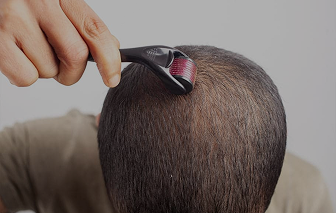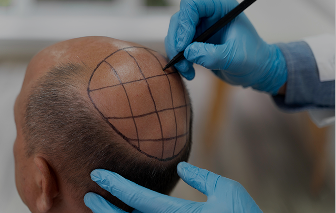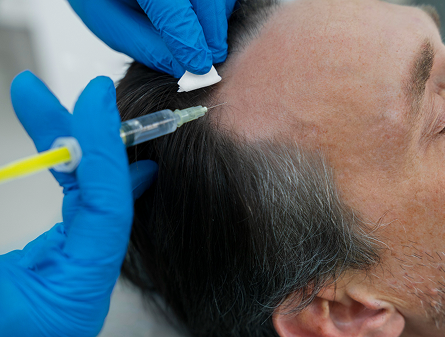Microneedling is a treatment which uses very small needles to create tiny punctures in the top layer of the skin called the epidermis. It can help to promote hair growth from dormant follicles by encouraging the natural healing properties of the skin.
A hair transplant is a surgical procedure where healthy hair is extracted and moved from the donor area of the scalp to the recipient area that is balding or thinning. This treatment can produce new hair growth where the follicles had stopped growing from 3-4 months after the surgery.
Microneedling is a minimally invasive treatment that can be performed at home or in a clinic in combination with other medications. A hair transplant provides a long-term, though not permanent, solution to hair loss that is typically only required once. Explore the comparison table below to see if a hair transplant or microneedling is best for you.
- Microneedling creates controlled micro-injuries in the scalp to stimulate healing and boost follicle growth.
- Unlike a hair transplant, it is non-surgical and less invasive.
- Hair transplants involve surgically relocating hair follicles to thinning areas.
- Compared to microneedling, they offer permanent results but require a surgical procedure.
- Microneedling is cost-effective, with at-home rollers priced around $30–$100.
- Professional sessions cost more but remain far cheaper than transplants.
- Hair transplants in Australia can cost $5,000–$15,000, depending on the extent of hair loss.
- More expensive upfront than microneedling, but considered a one-time investment.
- Microneedling is usually done weekly or every other week, and the effects are observed in 3–6 months.
- Long-term, consistent use is necessary to maintain results.
- Hair transplantation is typically completed in 1–2 operations, with results after 6–12 months.
- Compared to microneedling, there is minimal follow-up once healing is complete.
- Microneedling uses a dermaroller or microneedling pen to puncture the scalp with tiny needles.
- Unlike hair transplants, it triggers natural regeneration without moving follicles.
- Hair transplants relocate existing follicles to bald areas using surgical techniques like FUE or FUT.
- Compared to microneedling, it physically adds hair to areas of loss.
- Microneedling is safe, but can cause irritation or infection if tools aren’t properly sterilised.
- Fewer risks than surgical options, but requires careful handling when done at home.
- Hair transplants carry surgical risks like scarring, swelling, and infection.
- Compared to microneedling, post-procedure recovery is more prolonged and more intensive.
- Microneedling requires time, skill, and aftercare if performed at home.
- More flexible than a one-time surgery, but requires ongoing commitment.
- Hair transplants are performed by skilled surgeons, eliminating the need for user handling.
- Unlike microneedling, the skill is placed in the hands of the medical professionals.
- Microneedling tools are easily purchased online and don’t require prescriptions or consultations.
- More accessible than transplant procedures.
- Hair transplants require a clinical setting and consultation with a specialist.
- Compared to microneedling, access is limited by cost, geography, and availability of qualified surgeons.
- Microneedling offers gradual but sustainable improvement with continued use.
- Results may diminish if treatment is stopped in the long term.
- Hair transplants provide permanent results in transplanted areas.
- Unlike microneedling, they don’t require much upkeep after healing.
- Microneedling boosts absorption of topicals like minoxidil and is often used as a combination treatment.
- It works well as a support for the more effective penetration of other therapies.
- Hair transplants can be enhanced by follow-up microneedling or minoxidil for improved regrowth.
- Compared to microneedling, they serve as a base for other treatments rather than a support.
- Microneedling appeals to users seeking natural stimulation and an active role in hair care.
- Viewed as accessible and low-barrier.
- Hair transplants appeal to those looking for a dramatic and lasting transformation.
- Unlike microneedling, they offer visible change with minimal user effort post-procedure.
- Microneedling improves collagen production, skin texture, and scalp health.
- Offers combined hair and skin benefits.
- Hair transplants restore hair density but don’t improve scalp health or skin quality.
- Compared to microneedling, the benefits are limited to cosmetic hair coverage.
- Microneedling devices can be reused but require needle replacement, creating some waste.
- More eco-friendly than ongoing consumables but less so than a one-time surgery.
- Hair transplants generate clinical waste during the procedure, but no long-term product waste.
- Unlike microneedling, there are fewer consumables after the operation.
Shop our hair solutions
We are committed to providing affordable hair regeneration services for people all over Australia. Our formula can help you regain your confidence.
Shop Now

Comparison Summary
Microneedling may be a good choice if you have tried other treatments such as minoxidil and are not achieving the desired results. While there is still more research required into whether microneedling is effective as a monotherapy, in combination with medications like minoxidil it can prove to be effective in promoting hair growth.
A hair transplant provides long-lasting results and does not require much maintenance. When looking at microneedling vs transplant treatment cost comparisons, hair transplantation is a significant commitment, both in time and money. This is because it requires planning and adhering to aftercare instructions to ensure the best results.
Microneedling may be more accessible since at-home devices are becoming more popular. Some research may be required to pick the right device as cheaper dermarollers can be a safety issue. A hair transplant requires even more research as there is a wide range of clinics that offer the procedure and the skill of the surgeon and quality of the clinic will factor into your results.
User Guidance
While a hair transplant is a great long-term option, microneedling can provide results through a minimally invasive treatment. Microneedling sessions need to be maintained to keep results, however. There are more risks with a hair transplant compared to microneedling. As it is a surgical procedure, there are some risks associated with local anaesthetic and surgical infection.
Microneedling carries fewer risks but if performed at home can cause issues if your device is not sterilised to prevent the spread of bacteria. Microneedling is a fairly easy and accessible treatment that can allow you to control your hair loss from the comfort of your home.
A hair transplant requires skill and experience to achieve the best results, and the competitive industry can be difficult to navigate.
Take Our Hair Loss Quiz to See Which Treatment Suits You?
Take A Hair Quiz

Frequently Asked Questions
We have put some commonly asked questions.
Nunc scelerisque tincidunt elit. Vestibulum non mi ipsum. Cras pretium suscipit tellus sit amet aliquet. Vestibulum maximus lacinia massa nontor.
Platelet-rich plasma (PRP) treatment involves drawing blood from the patient, isolating the beneficial nutrients and injecting it into the scalp where hair loss is occurring. This promotes hair growth and has many other applications from encouraging healing to skin rejuvenation.
Platelet-rich plasma (PRP) treatment involves drawing blood from the patient, isolating the beneficial nutrients and injecting it into the scalp where hair loss is occurring. This promotes hair growth and has many other applications from encouraging healing to skin rejuvenation.
Platelet-rich plasma (PRP) treatment involves drawing blood from the patient, isolating the beneficial nutrients and injecting it into the scalp where hair loss is occurring. This promotes hair growth and has many other applications from encouraging healing to skin rejuvenation.







 See All
See All